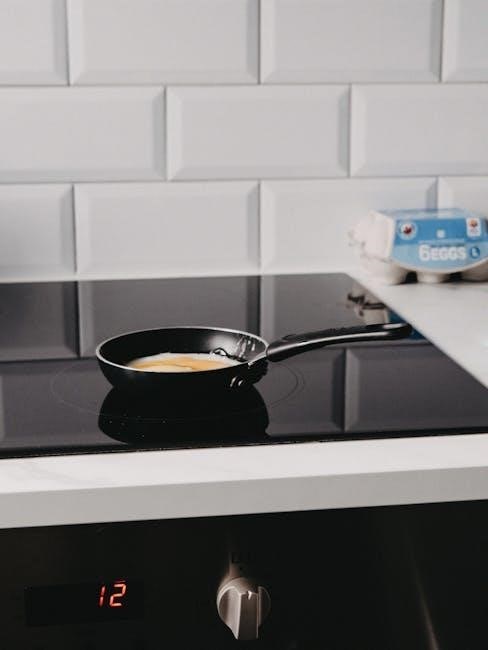GE Profile Induction Cooktop Manual: A Comprehensive Guide
Unlock the full potential of your GE Profile induction cooktop with our comprehensive guide! This resource provides essential information, from understanding induction technology to troubleshooting common issues․ Maximize your cooking experience and ensure safe, efficient operation with our detailed manual․
Finding Your Specific GE Profile Cooktop Model Manual
Locating the correct manual for your specific GE Profile induction cooktop model is crucial for optimal use and maintenance․ GE Appliances offers a comprehensive online resource for appliance manuals dating back to 2000․ To find your manual, visit the geappliances․com website and enter your model number into the search box located at the top of the page․
Once you enter the model number and press the search icon or Enter key, you will be directed to the specific product page for your appliance․ This page contains detailed specifications, owner manuals, and other support documents relevant to your model․
Alternatively, you can often find the model number on a sticker or plate located on the cooktop itself․ Common locations include underneath the cooktop, on the side, or near the control panel․ Once you have the model number, you can also try searching directly on the GE Appliances support website or using a general web search engine․
Ensure you download or view the correct manual to access accurate information regarding your cooktop’s features, functions, safety precautions, and troubleshooting tips; Using the wrong manual could lead to incorrect operation or damage to your appliance․ Having the right manual is essential for a safe and satisfying cooking experience․
Understanding Induction Cooking Technology
Induction cooking technology differs significantly from traditional electric or gas cooktops․ Instead of heating a burner that then heats the cookware, induction cooktops use electromagnetic energy to directly heat the pot or pan itself․ This process involves an induction coil beneath the ceramic glass surface generating a magnetic field․ When a compatible cookware made of a ferromagnetic material (like cast iron or some stainless steel) is placed on the cooking zone, the magnetic field induces an electrical current within the cookware․
This electrical current generates heat directly within the pot or pan, leading to extremely fast and efficient heating․ The cooktop surface itself remains relatively cool, as it’s only heated by the residual heat from the cookware․ This results in a safer cooking environment, reducing the risk of burns․
Induction cooking offers precise temperature control, allowing for rapid adjustments to heat levels․ The responsiveness is comparable to gas cooktops, making it ideal for delicate sauces and searing meats․ Because the heat is generated directly in the cookware, energy efficiency is significantly improved compared to other cooking methods․ This translates to lower energy bills and a reduced environmental impact․ Understanding these principles is vital for effectively using and maintaining your GE Profile induction cooktop․
Safety Precautions and Proper Usage
Prioritizing safety is paramount when using your GE Profile induction cooktop․ Always ensure the cooktop is properly installed and grounded according to the manufacturer’s instructions to prevent electrical hazards․ Never operate the cooktop if the glass surface is cracked or damaged, as this could pose a risk of electric shock․ Keep flammable materials away from the cooktop while in use, and never leave it unattended when cooking․
Only use cookware that is suitable for induction cooking․ Avoid using cookware that is warped or has uneven bottoms, as this can affect heating performance and potentially damage the glass surface․ When lifting or moving heavy pots and pans, exercise caution to prevent scratches or cracks on the cooktop․
After each use, allow the cooktop to cool completely before cleaning․ Use a cooktop cleaner specifically designed for ceramic glass surfaces to avoid scratching or damaging the surface․ Never use abrasive cleaners or scouring pads․ Familiarize yourself with the control panel and its functions before using the cooktop․ Use the control lock feature to prevent accidental activation, especially when children are present․ By adhering to these safety precautions and usage guidelines, you can enjoy safe and efficient cooking with your GE Profile induction cooktop․

Suitable Cookware for GE Profile Induction Cooktops
Selecting the correct cookware is crucial for optimal performance and safety with your GE Profile induction cooktop․ Induction cooking relies on magnetic fields to directly heat the cookware, so only pots and pans made from ferromagnetic materials are compatible․ These materials include cast iron, enameled cast iron, and many types of stainless steel․
To determine if your cookware is suitable, check for the induction compatibility symbol on the bottom of the pan, typically a coiled symbol․ If the symbol is absent, test the cookware by placing a magnet on the bottom․ If the magnet strongly adheres, the cookware is likely compatible․
Avoid using cookware made from aluminum, copper, glass, or ceramic unless they have a ferromagnetic base specifically designed for induction cooking․ The size of the cookware also matters; ensure the diameter of the pot or pan matches the size of the cooktop element for efficient heating․ Using undersized cookware can result in poor performance, while oversized cookware may not be detected by the induction element․ By choosing suitable cookware, you will maximize the efficiency and lifespan of your GE Profile induction cooktop․

Operating the Touch Controls
The GE Profile induction cooktop features intuitive touch controls that allow for precise and easy operation․ To activate a cooking zone, first ensure the cooktop is powered on․ Then, gently touch the desired burner’s control to select it․ A light or indicator will illuminate, confirming the selection․
Adjust the heat level by sliding your finger along the control bar or by tapping the “+” and “-” symbols; The cooktop offers a range of heat settings, allowing for simmering, sautéing, and boiling with accuracy․ Some models also feature a “boost” function for rapid heating․
For safety, the cooktop includes a control lock feature that prevents accidental activation․ To engage or disengage the control lock, press and hold the lock symbol for a few seconds․ This is especially useful when cleaning the cooktop surface or when children are present․
The touch controls are sensitive to moisture, so ensure your fingers are dry and the cooktop surface is clean․ A slight film of water can interfere with the controls’ responsiveness․ Familiarize yourself with the specific layout and functions of your model by referring to the owner’s manual for detailed instructions․

Cleaning and Maintenance of the Cooktop Surface
Maintaining the pristine condition of your GE Profile induction cooktop surface is essential for both its appearance and performance․ Regular cleaning prevents buildup and ensures optimal heat transfer․ Always allow the cooktop to cool completely before cleaning to avoid burns․
For routine cleaning, use a soft, damp cloth or sponge with a mild dish soap․ Gently wipe the surface to remove spills and splatters․ Avoid abrasive cleaners, scouring pads, and steel wool, as these can scratch the glass surface․
For stubborn stains or cooked-on residue, use a ceramic cooktop cleaner specifically designed for glass surfaces; Apply a small amount of cleaner to the affected area and gently rub with a soft cloth or sponge․ Wipe away the cleaner with a clean, damp cloth and dry thoroughly․
Scrape off sugary spills immediately with a cooktop scraper while they are still warm to prevent damage․ Regularly clean around the control panel to remove any grease or grime․ A clean cooktop not only looks better but also ensures the touch controls function properly․
Troubleshooting Common Issues (e․g․, burner only stays on for a few seconds)
Encountering issues with your GE Profile induction cooktop can be frustrating, but many problems have simple solutions․ One common issue is the burner only staying on for a few seconds․ This often indicates an incompatible cookware issue․ Induction cooktops require cookware with a magnetic base to function correctly․ Ensure your pots and pans are suitable for induction cooking․
Another possible cause is overheating․ The cooktop may automatically shut off to prevent damage․ Allow the cooktop to cool down completely before attempting to use it again․ If the problem persists, check for error codes on the display panel․ These codes can provide valuable information about the issue․
Power supply problems can also cause intermittent burner operation․ Ensure the cooktop is properly connected to a functioning power outlet․ If you’ve checked cookware, overheating, and power, consider resetting the cooktop by turning off the breaker for a few minutes, then turning it back on․ If the problem persists, consult the user manual or contact GE support․
Activating and Using Convection Mode (if applicable)
If your GE Profile appliance includes a convection oven alongside the induction cooktop, understanding how to properly activate and utilize the convection mode is crucial for optimal cooking results․ Convection cooking uses a fan to circulate hot air throughout the oven cavity, promoting even heat distribution and faster cooking times․
To activate convection mode, typically you’ll find a dedicated “Convection” button on the oven’s control panel․ Pressing this button will initiate the convection fan․ Some models offer different convection settings, such as “Convection Bake” or “Convection Roast,” each designed for specific types of cooking․ Consult your owner’s manual to understand the nuances of each setting․
When using convection mode, it’s often recommended to reduce the oven temperature by about 25 degrees Fahrenheit compared to traditional baking․ This is because the circulating air cooks food more efficiently․ Monitor your food closely during the initial cooking stages to prevent over-browning․ Ensure proper spacing between dishes to facilitate airflow․

Understanding Error Codes and Messages
Modern GE Profile induction cooktops are equipped with sophisticated sensors and diagnostic systems that can detect potential issues during operation․ When a problem arises, the cooktop may display an error code or message on its control panel․ Understanding these codes is crucial for identifying and resolving problems effectively․
Each error code corresponds to a specific issue, ranging from simple problems like incompatible cookware to more complex malfunctions requiring professional service․ Consult your GE Profile induction cooktop’s manual for a comprehensive list of error codes and their corresponding explanations․
The manual will provide troubleshooting steps you can take to resolve the issue․ For example, an error message might indicate that the cookware is not suitable for induction cooking, prompting you to switch to compatible pots and pans․ Other error codes may indicate a power supply problem, overheating, or a malfunctioning sensor․
If the troubleshooting steps in the manual do not resolve the issue, it’s essential to contact GE Appliances customer support or a qualified appliance repair technician․ Attempting to repair the cooktop yourself without proper knowledge and tools can be dangerous and may void the warranty․
Warranty Information and Support Resources
Your GE Profile induction cooktop comes with a warranty that protects you against manufacturing defects and malfunctions․ The warranty period and coverage details vary depending on the specific model․ Consult your owner’s manual or the GE Appliances website for detailed warranty information․
Typically, the warranty covers parts and labor for a specified period, usually one year from the date of purchase․ Some components, like the glass cooktop surface, may have extended warranty coverage․ To ensure your warranty remains valid, it’s crucial to follow the installation and usage instructions outlined in the manual․
If you encounter any issues with your cooktop during the warranty period, contact GE Appliances customer support for assistance․ They can help diagnose the problem and arrange for repairs if necessary․ Make sure to have your model number and proof of purchase readily available when contacting support․
In addition to warranty support, GE Appliances offers a wealth of online resources, including FAQs, troubleshooting guides, and how-to videos․ You can also find your cooktop’s manual on the GE Appliances website․ These resources can help you resolve common issues and maintain your cooktop’s performance․ For more complex problems, consider contacting a qualified appliance repair technician․


